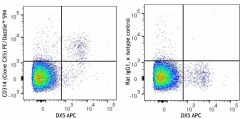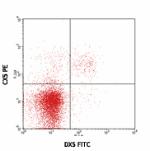- Clone
- CX5 (See other available formats)
- Regulatory Status
- RUO
- Other Names
- CD314
- Isotype
- Rat IgG1, κ

-

C57/BL6 mouse splenocytes were stained with TruStain fcX™ (clone 93), then True-Stain Monocyte Blocker™ (Cat. No. 426103), anti-mouse CD49b (clone DX5) APC, and anti-mouse CD314 (clone CX5) PE/Dazzle™ 594 (left) or Rat IgG1, κ isotype control PE/Dazzle™ 594 (right).
| Cat # | Size | Price | Quantity Check Availability | ||
|---|---|---|---|---|---|
| 130213 | 25 µg | $124.00 | |||
| 130214 | 100 µg | $335.00 | |||
This antibody has been reported to block binding of NKG2D to its ligands, RAE-1 and H60, and inhibition of NKG2D-dependent NK-cell cytotoxicity.
Product Details
- Verified Reactivity
- Mouse
- Antibody Type
- Monoclonal
- Host Species
- Rat
- Immunogen
- Mouse NKG2D
- Formulation
- Phosphate-buffered solution, pH 7.2, containing 0.09% sodium azide.
- Preparation
- The antibody was purified by affinity chromatography and conjugated with PE/Dazzle™ 594 under optimal conditions.
- Concentration
- 0.2 mg/ml
- Storage & Handling
- The antibody solution should be stored undiluted between 2°C and 8°C, and protected from prolonged exposure to light. Do not freeze.
- Application
-
FC - Quality tested
- Recommended Usage
-
Each lot of this antibody is quality control tested by immunofluorescent staining with flow cytometric analysis. For flow cytometric staining, the suggested use of this reagent is ≤0.25 µg per million cells in 100 µl volume. It is recommended that the reagent be titrated for optimal performance for each application.
* PE/Dazzle™ 594 has a maximum excitation of 566 nm and a maximum emission of 610 nm.
- Excitation Laser
-
Blue Laser (488 nm)
Green Laser (532 nm)/Yellow-Green Laser (561 nm)
- Application Notes
-
To reduce non-specific binding, preincubate cells with purified anti-mouse CD16/CD32, clone 93 (Cat No 101301/2) is recommended.
This product is for in vitro research use only. It is not to be used for commercial purposes. Use of this product to produce products for sale or for diagnostic therapeutic or drug discovery purposes is prohibited. In order to obtain a license to use this product for commercial purposes contact The Regents of the University of California.
-
Application References
(PubMed link indicates BioLegend citation) -
- Ogasawara K, et al. 2003. Immunity 18:41. (Block)
- Ogasawara K, et al. 2004. Immunity 20:757. (Block)
- Kong LY, et al. 2010. Clin. Cancer Res. 16:2550. PubMed
- Product Citations
-
- RRID
-
AB_2728147 (BioLegend Cat. No. 130213)
AB_2728147 (BioLegend Cat. No. 130214)
Antigen Details
- Structure
- NKG2D is a lectin-like type II transmembrane protein. It serves as a stimulatory receptor to activate NK cells via the non-covalently associated DAP10 or DAP 12 daptor protein.
- Distribution
-
NK, NKT cells
- Ligand/Receptor
- RAE, H60,
- Cell Type
- NK cells, NKT cells
- Biology Area
- Costimulatory Molecules, Immunology
- Molecular Family
- CD Molecules
- Gene ID
- 27007 View all products for this Gene ID
- UniProt
- View information about CD314 on UniProt.org
Other Formats
View All CD314 Reagents Request Custom Conjugation| Description | Clone | Applications |
|---|---|---|
| Purified anti-mouse CD314 (NKG2D) | CX5 | FC |
| PE anti-mouse CD314 (NKG2D) | CX5 | FC |
| APC anti-mouse CD314 (NKG2D) | CX5 | FC |
| PE/Dazzle™ 594 anti-mouse CD314 (NKG2D) | CX5 | FC |
| TotalSeq™-A0835 anti-mouse CD314 (NKG2D) | CX5 | PG |
| Ultra-LEAF™ Purified anti-mouse CD314 (NKG2D) | CX5 | FC,Block |
| TotalSeq™-C0835 anti-mouse CD314 (NKG2D) | CX5 | PG |
| TotalSeq™-B0835 anti-mouse CD314 (NKG2D) | CX5 | PG |
Compare Data Across All Formats
This data display is provided for general comparisons between formats.
Your actual data may vary due to variations in samples, target cells, instruments and their settings, staining conditions, and other factors.
If you need assistance with selecting the best format contact our expert technical support team.
-
Purified anti-mouse CD314 (NKG2D)
-
PE anti-mouse CD314 (NKG2D)

C57BL/6 splenocytes stained with DX5 FITC and CX5 PE -
APC anti-mouse CD314 (NKG2D)

C57BL/6 splenocytes stained with DX5 PE and CX 5 APC -
PE/Dazzle™ 594 anti-mouse CD314 (NKG2D)

C57/BL6 mouse splenocytes were stained with TruStain fcX™ (c... -
TotalSeq™-A0835 anti-mouse CD314 (NKG2D)
-
Ultra-LEAF™ Purified anti-mouse CD314 (NKG2D)
-
TotalSeq™-C0835 anti-mouse CD314 (NKG2D)
-
TotalSeq™-B0835 anti-mouse CD314 (NKG2D)
